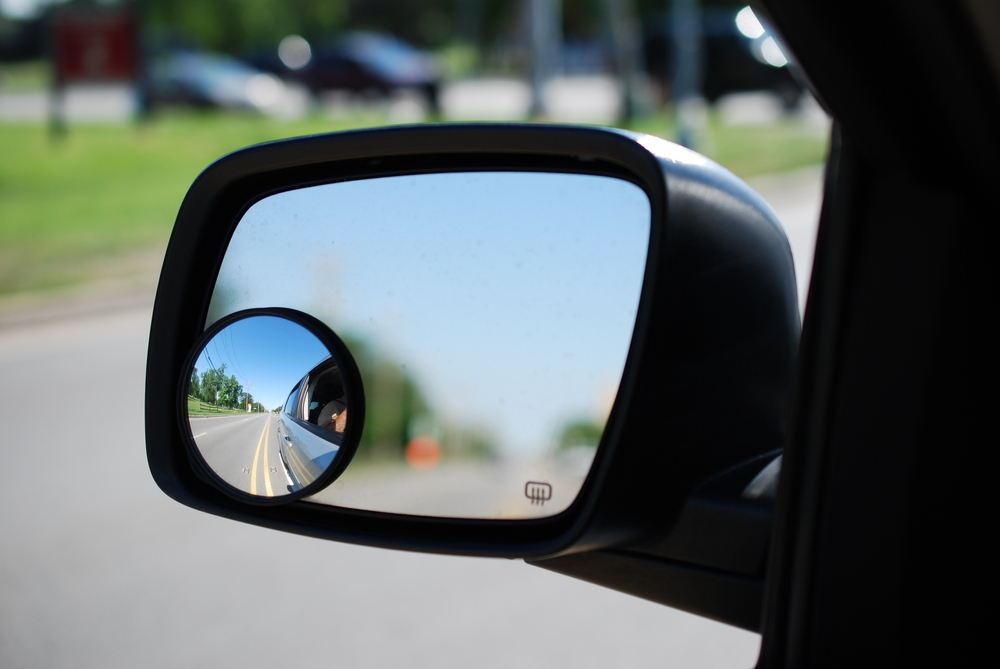Blind spots are a leading cause of truck accidents. Trucks have much larger blind spots than cars because of their size and layout, and truck drivers must always keep a close eye on these areas. When they fail to do so before changing lanes or making tight turns, they risk overlooking nearby passenger vehicles until it is too late.
Contacting a Chicago truck accident lawyer after an accident is a crucial step to ensure that the injured party receives fair compensation and that the legal complexities of the case are properly addressed.
What Is a Blind Spot?

For example, if you’re driving a car and want to change lanes, you might glance in your side mirror. If a vehicle is in your blind spot, you won’t see it in the mirror. This dynamic is why drivers learn to turn their heads and look over their shoulders before changing lanes. This action allows them to check those hidden areas their mirrors can’t cover.
Drivers must always be aware of their blind spots because other road users can lurk out of sight in these areas. To manage blind spots, drivers should adjust their mirrors correctly, use them frequently, and always check over their shoulders before changing lanes or turning.
If a driver doesn’t check their blind spots before making a move, they might not see another vehicle, and could cause an accident.
Why Are Truck Blind Spots so Large?
Truck blind spots are large because of the size and design of trucks. Trucks are much bigger than regular cars, so they naturally have more prominent blind spots.
The height and length of a truck play a significant role in creating these large blind areas. Since a truck sits higher off the ground, the driver sits at a level where smaller vehicles nearby, especially those close to the truck, might not be visible.
Beyond being tall, trucks are also long vehicles. This length means there are more areas along the sides and back where the driver can’t see. Unlike cars, trucks don’t have rearview mirrors.
And while truckers have several large side mirrors to aid them, these mirrors can’t show the entire side or back of the truck. This situation makes it harder for truckers to see vehicles directly behind or beside them and increases the risk of blind spot accidents.
Where Are a Truck’s Main Blind Spots?
Large trucks have four main blind spots or no-zones. Vehicles, pedestrians, and objects within these no-zones are entirely out of the truck driver’s line of sight. Drivers should familiarize themselves with these no-zones and learn how to avoid lingering within them.
The Front Blind Spot
The front blind spot of a truck, or the front no-zone, is a critical area where the truck’s nose can hide smaller vehicles from the truck driver’s view. Due to the elevated position of the truck’s cabin, a sizable area directly in front of the truck falls outside the driver’s line of sight.
This blind spot can extend up to 20 feet ahead, though it varies in size depending on the truck’s design and its cabin height.
When a truck follows another vehicle too closely, the truck driver could be completely unaware of that vehicle’s presence. This problem becomes particularly hazardous in situations where the trucker needs to brake suddenly. Vehicles in this zone are at risk of override accidents, as truck drivers might not have time to react upon noticing the car.
The Rear Blind Spot
The rear blind spot of a truck is a zone directly behind the truck that is invisible to the truck driver. This is partly because trucks lack rearview mirrors, standard features in smaller vehicles. The blind spot extends up to 200 feet from the back of the trailer, creating a large area where cars can hide entirely from the truck driver’s view.
The presence of a vehicle in this blind spot is particularly perilous, as the smaller vehicle’s driver often cannot see enough to anticipate the truck’s movements.
The truck’s trailer can block the rest of the traffic from view, reducing or eliminating the other driver’s ability to see and react to sudden stops or changes in speed. Furthermore, if a trucker reverses into this blind spot, there’s a significant risk of collision since they can’t see directly behind them.
The Right-Side Blind Spot
The right-side blind spot of a truck is one of the most extensive and dangerous. It spans the entire length of the truck and can extend outward for three lanes.
This large blind spot exists because the truck’s cabin is high off the road, the trailer extends some 50 feet behind it, and the trucker sits on the left side of the cab, which obscures their view to the right.
Vehicles driving alongside the right side of a truck, especially just behind the cab, are at risk of being in the truck driver’s blind spot.
If a truck driver decides to change lanes or make a right turn without checking this no-zone, there’s a significant chance of colliding with a vehicle in it. Truck drivers should use their side mirrors constantly and check this blind spot thoroughly before any lateral movements to reduce the risk of accidents. If they don’t, these drivers can face liability for blind spot collisions.
The Left-Side Blind Spot

Truck drivers must frequently check their left-side mirrors, especially before making lane changes or turning to the left. This habit is especially important in high-traffic situations or on multi-lane roads, where other drivers can approach and pass large trucks on their left-hand sides.
Points of Impact in Truck Accidents
Unfortunately, there are no reliable statistics about how often truck accidents occur due to blind spot issues.
That said, the Federal Motor Carrier Safety Administration (FMCSA) tracks commercial truck accidents by point of impact, which provides a valuable metric of how dangerous each no-zone is:
- The front of the truck is the most common initial point of impact in fatal truck crashes, accounting for 2,885 (57.6 percent) of these accidents.
- The truck’s rear was the next most common initial point of impact, with 964 (19.3 percent) fatal truck accidents involving this impact site.
- The left side of large trucks was the initial point of impact in 8.7 percent of fatal truck crashes or 436 accidents.
- There were 331 fatal truck crashes involving right-side impacts, which made up 6.6 percent of the total.
Common Types of Truck Blind Spot Accidents
Blind spots are a significant factor in many truck accidents because they hide other vehicles from a truck driver’s view.
When a truck driver fails to notice a vehicle in their no-zones, the chance of any of the following accidents increases:
- Lane Change Accidents: These crashes occur when a truck driver moves over a lane without seeing a vehicle in their blind spot, thus striking the other vehicle or forcing it off the road. Truckers often fail to spot smaller vehicles in these blind spots, especially if other drivers linger too long next to the truck or do not maintain safe distances.
- Merging Accidents: Merging accidents can happen when a truck driver enters or exits a highway or when a multi-lane roadway they’re driving on narrows. These accidents can push smaller vehicles out of their lanes, into other traffic, or even off the road. The truck’s size makes it harder for truckers to see vehicles in the blind spots directly next to their cabins or on the far sides of their trucks.
- Rear-End Collisions: A rear-end collision can occur when a trucker doesn’t react in time to avoid striking a vehicle that has slowed or stopped in front of them. Since trucks require a greater stopping distance than smaller vehicles, they are more likely to crash when operators follow too closely behind, particularly if traffic suddenly slows or halts.
- Turning Accidents: Truck drivers making turns, especially right turns, can hit vehicles in the truck’s blind spots. Since trucks make wide turns, vehicles that are on the inside of the turn are often invisible to the truck driver. A turning truck is particularly dangerous for adjacent pedestrians, cyclists, motorcyclists, and smaller vehicles.
- Sideswipe Accidents: Similar to lane-change or merging accidents, this kind of accident can happen when the driver of a smaller vehicle attempts to overtake a truck but is in the truck driver’s side blind spot. Not seeing the vehicle, the truck driver might veer into the lane of the overtaking vehicle, causing a sideswipe collision.
- Backing up Accidents: When a truck driver backs up, especially in areas like loading docks or parking lots, there is a substantial blind spot directly behind them that they back up into. If the truck driver does not see someone behind the truck before reversing, they risk striking that person. These accidents are particularly dangerous for pedestrians and smaller vehicles that a truck’s blind spot can completely hide from the driver’s view.
Why Blind Spot Truck Accident Cases Are So Complex
Blind spot truck accident cases are more complex than other accident injury cases for several reasons.
First, trucks are commercial vehicles, which means they often involve corporate ownership and large commercial insurance policies. This adds several layers of bureaucracy, available compensation, and, perhaps most critically, corporate liability. Each party has a different agenda and incentive to deny responsibility for the accident.
Second, determining liability in truck accidents is complex. A successful truck claim must consider the truck driver’s actions, the trucking company’s policies, and sometimes even the actions of other drivers.
It’s not always clear who made the mistake that led to the accident. Sometimes, the truck driver fails to check their blind spots. Other times, it’s another driver behaving aggressively and failing to account for the trucker’s limited visibility.
Third, there are federal and state regulations that apply to trucks but not to regular vehicles. These rules cover things like how long drivers can be on the road without breaks and how they must maintain their vehicles.
Lawyers need to understand these regulations to determine if the trucking company or driver didn’t follow the rules, which can affect how they handle the case.
Lastly, the severity of injuries in truck accidents is often greater. This means medical investigations and expert testimonies become more complex as the injuries are more severe and the treatment more extensive. All these factors mean that lawyers and insurance companies must work harder to resolve these cases.
How a Blind Spot Truck Accident Lawyer Can Help
If you know or suspect you have a blind spot truck accident claim, having a lawyer by your side can make a big difference in its outcome.
A lawyer can help you in many different ways, including by:
-
- Investigating the accident to identify evidence of liability
- Consulting accident reconstruction specialists and other experts
- Interviewing witnesses who saw the accident
- Reviewing trucking company records for compliance with regulations
- Recovering critical evidence that may remain in the trucking company’s hands, such as the data from the vehicle’s “black box”
- Determining a fair value for your claim
- Identifying all potential sources of compensation
- Preparing claim documents accurately and filing them on your behalf
- Handling all communication with the trucking company’s lawyers
- Negotiating with insurance companies for a fair settlement
- Advising you on whether to accept settlement offers or go to trial
- Challenging any attempts to undervalue or deny your claim
- Representing you in court, if necessary

